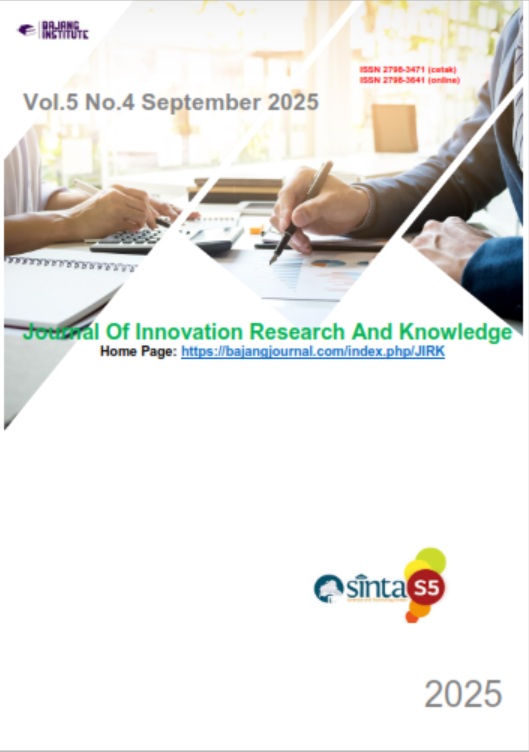MERAJUT IDENTITAS: ADAPTASI TATREEZ PALESTINA DALAM BATIK
DOI:
https://doi.org/10.53625/jirk.v5i4.11255Keywords:
Palestina, Batik Indonesia, Representasi BudayaAbstract
Penelitian ini bertujuan untuk mengeksplorasi adaptasi motif Tatreez Palestina—seni bordir tradisional yang sarat makna simbolis dan identitas budaya—ke dalam teknik batik Indonesia sebagai bentuk representasi lintas budaya dalam seni tekstil kontemporer. Tatreez, yang diwariskan secara matrilineal oleh perempuan Palestina, tidak hanya menjadi ekspresi estetik, tetapi juga simbol resistensi terhadap penjajahan. Sementara itu, Batik Indonesia merupakan warisan budaya takbenda UNESCO yang juga sarat nilai filosofis dan sosial. Penelitian ini menggunakan pendekatan kualitatif deskriptif dengan metode studi literatur, observasi lapangan di studio batik, wawancara semi-terstruktur dengan pengrajin, serta eksplorasi visual terhadap desain motif dan teknik produksi tekstil. Temuan utama menunjukkan keberhasilan integrasi elemen-elemen visual khas Tatreez, seperti cypress tree, olive branch, dan moon of Bethlehem, ke dalam komposisi batik tulis, cap, dan sulam, yang menghasilkan karya tekstil dan busana dengan narasi estetik dan politis yang kuat. Proyek ini menunjukkan bahwa perpaduan dua teknik dari konteks budaya berbeda dapat menciptakan inovasi artistik yang bermakna secara estetik dan politis. Karya yang dihasilkan menjadi media refleksi identitas, perlawanan, dan solidaritas lintas bangsa di era globalisasi, serta menawarkan pendekatan baru dalam pelestarian budaya melalui seni kontemporer.
References
G. Pollock, Encounters in the Virtual Feminist Museum: Time, Space and the Archive, 1st ed. London: Routledge, 2007. doi: https://doi.org/10.4324/9781003416708.
S. Khullar, “Palestinian Tatreez Offers Grief and Solace: How passing the traditional embroidery art from one generation to another continues to anchor a people with their past,” New Lines Magazine, Jan. 29, 2024. Accessed: Oct. 03, 2024. [Online]. Available: https://newlinesmag.com/spotlight/palestinian-tatreez-offers-grief-and-solace/
K. A. D. Retnoningtyas, H. R. Aulia, and D. B. Assamoah, “Representasi Budaya Batik dalam Film Sekar Karya Kamila Andini serta Implikasinya sebagai Bahan Ajar BIPA,” Jurnal Nusantara Raya, vol. 1, no. 3, p. 167, Nov. 2022, doi: https://doi.org/10.24090/ jnr.v1i3.8005.
D. Soebagiyo and M. Wahyudi, “Analisis Kompetensi Produk Unggulan Daerah Pada Batik Tulis Dan Cap Solo Di Dati II Kota Surakarta,” Jurnal Ekonomi Pembangunan Universitas Muhammadiyah Surakarta, vol. 9, no. 2, 2008.
S. (Ed. ) Hall, Representation: Cultural representations and signifying practices. Sage in association with The Open University, 1997.
L. M. Ganiem, “Pemaparan Kajian Teori/Pustaka,” in Metodologi Penelitian Pendidikan, N. Saputra, Ed., Aceh: Yayasan Penerbit Muhammad Zaini, 2022, ch. 5, p. 255.
I. G. S. Radja and L. R. Sunjaya, “Representasi Budaya Jember dalam Jember Fashion Carnival: Pendekatan Teori Representasi Stuart Hall,” WISSEN: Jurnal Ilmu Sosial dan Humaniora, vol. 2, no. 3, pp. 13–20, Jun. 2024, doi: 10.62383/wissen.v2i3.160.
C. Y. Güner, “Diaspora and Tatreez: Reflections in Stitch,” Journal of History of Design and Curatorial Studies, no. 5, Parsons School of Design, 2021, Accessed: Oct. 03, 2024. [Online]. Available: https://adht.parsons.edu/historyofdesign/objectives/diaspora-and-tatreez/
B. Sudardi, “Batik Motifs as a Means of Building for Peace: Javanese Perspective,” International Journal of Law, Government and Communication, vol. 6, no. 25, pp. 09–16, Sep. 2021, doi: 10.35631/ijlgc.625002.
S. Maziyah, “Kawung: Acculturation of Culture Decorative Motif Development Java Impact of Indian and Chinese Trade in IX-XV AD Centuries,” in Proceedings of the 4th International Conference on Indonesian Social and Political Enquiries, ICISPE 2019, B. Prabawani, R. Manalu, L. K. Alfirdaus, R. Hanani, and M. Rosyidin, Eds., Semarang: EAI, Apr. 2020, p. doi: 10.4108/eai.21-10-2019.2294437.
A. D. Soemardi, “Understanding ‘Batik Belanda’ in Dutch Society via Co-Creation Experience of Creative Tourism Practice,” Journal of Visual Art and Design, p., 2024, doi: 10.5614/j.vad.2023.15.2.6.
A. Y. S. Melati, D. Nurcahyanti, and R. Widayat, “Enhancing the Identity of Creative Industries Through the Development of Batik Motifs Inspired by Local Wisdom,” International Journal of Advances in Social Sciences and Humanities, p., 2025, doi: 10.56225/ijassh.v4i1.385.
A. K. Anil, “Cultural Hybridity in Focus: Exploring Globalized Identities Through Jhumpa Lahiri’s The Namesake and Alejandro González Iñárritu’s Babel,” International Journal of Environment, Agriculture and Biotechnology, vol. 8, no. 6, pp. 270–272, 2023, doi: https://dx.doi.org/10.22161/ijeab.86.23.
L. M. Ganiem, “Menulis Bab Pembahasan,” in Karya Tulis Ilmiah: Teori & Panduan Praktis Penulisan Karya Ilmiah, PT Sonpedia Publishing Indonesia, 2023, ch. 11, p. 278.
W. Ghnaim, Tatreez and Tea: Embroidery and Storytelling in the Palestinian Diaspora, Illustrated. Wafa Ghnaim, 2018. [Online]. Available: https://books.google.co.id/ books?id=PAaFvQEACAAJ
A. A. Hidayat, “Analisis Makna Semiotik dan Representasi Budaya Tiongkok pada Motif Batik Lasem,” Universitas Brawijaya, Malang, 2017. Accessed: Oct. 03, 2024. [Online]. Available: https://repository.ub.ac.id/id/eprint/7991/
Guntur, “Motif hias alas-alasan pada batik dalam ritual tingalan jumenengan dan perkawinan di Keraton Kasunanan Surakarta: Kajian bentuk, fungsi dan makna ,” Universitas Gajah Mada, Yogyakarta, 2010.
S. Malherbe, “The Cypress Tree,” World Literature Today. Accessed: Jul. 22, 2025. [Online]. Available: https://worldliteraturetoday.org/2021/summer/cypress-tree-shereen-malherbe
A. Khaled, “Palestinian Tatreez: Embroidering Resistance and Remembrance,” Atmos, Mar. 02, 2023. Accessed: Oct. 03, 2024. [Online]. Available: https://atmos.earth/ palestinian-tatreez-embroidery-radical-history-resistance/
C. N. Power, “Education – The Tree of Life,” in The Power of Education: Education in the Asia-Pacific Region: Issues, Concerns and Prospects, vol. 27, Singapore: Springer Singapore, 2015, pp. 107–124. doi: 10.1007/978-981-287-221-0_7.
M. Gajić, S. Vujadinović, and S. Popović, “Globalization and Cultural Identity,” Herald, no. 20, 2016, doi: https://doi.org/10.7251/HER2016041G.
Kasiyan, “Representasi Tradisi dan Budaya Lokal dalam Seni Rupa Kontemporer Yogyakarta,” Imaji: Jurnal Seni dan Pendidikan Seni, vol. 7, no. 2, pp. 159–174, 2009, doi: http://dx.doi.org/10.21831/imaji.v7i2.6632.
L. Zaks, “The Culture-Centred Paradigm in Contemporary Art,” Quaestio Rossica, vol. 8, Jun. 2021, doi: https://doi.org/10.15826/qr.2021.2.587.













